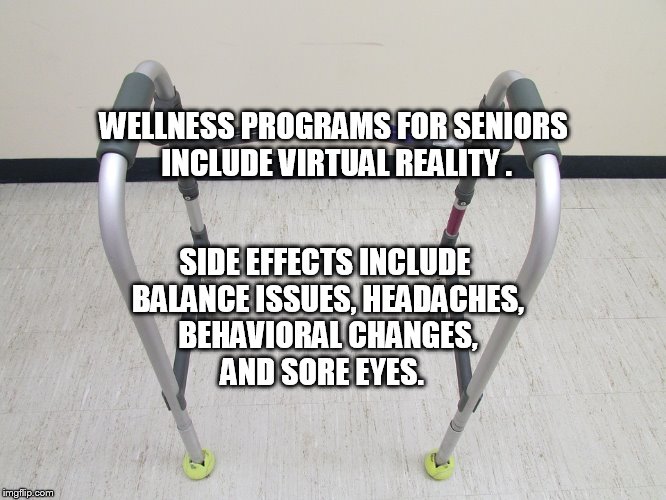 By B.N. Frank
By B.N. Frank
Getting old has never been for sissies. Today’s seniors are also experiencing a world that’s become addicted to technology. Now Virtual Reality is being marketed to them as part of “Wellness Programs”
“The spillover effects from the VR experience surprised Visual’s president Esra Kucukciftci and founder/CEO Chuck Olsen. “People were more likely to socialize with friends and family—we presume because they had something to talk about that’s not, like, who broke their hip…”
Wow. Is it better for us or better for grandma and grandpa if they have something else to talk about besides their concerns regarding their loved ones?
There has already been backlash regarding Virtual Reality programs being created and promoted for children. Side effects for children and adults include
- Balance problems
- Behavioral changes
- Headaches
- Sore Eyes
In children, it’s even been said it can cause cognitive problems and unknown consequences.
From the Association for Psychological Science (February 2014): “Virtual avatars may impact real-world behavior”
“Our results indicate that just five minutes of role-play in virtual environments as either a hero or villain can easily cause people to reward or punish anonymous strangers,” says lead researcher Gunwoo Yoon of the University of Illinois at Urbana-Champaign.
That sounds a lot like it can cause users to behave like sociopaths. Do we want that for grandma and grandpa, too?
Virtual Reality isn’t the only way to promote more socialization with friends and family. It’s not the only way to provide seniors with something to talk about other than broken hips. There are senior centers in many American communities. Several years ago, a documentary was even produced about senior citizens being trained to sing and perform current music.
Yoga and meditation are also helping people of all ages feel better – including seniors. Even children growing up in “The Digital World” are thriving from non-digital programs.
Unfortunately for seniors, visits with family members, friends, and caretakers now usually include at least one cell phone or iPad. Sometimes this is necessary to be “on call” for emergencies. Pagers were once used for this purpose but cell phones and wearable technology have taken their place.
As we know, these devices are capable of so much more though than being “on call.” CBS’s 60 Minutes ran a segment in 2017 called “Brain Hacking.” Tech inventors are paid to deliberately create software that is “sticky” to affect our brains’ neurotransmitters and dopamine levels. This may lead to “Digital Addiction and other behavioral and emotional health issues. Many other sources have confirmed this as well.
Cell phones and other new devices constantly emit wireless WiFi radiation. 2012 research revealed that exposure can disrupt the blood-brain barrier which can cause it to leak. This can lead to reduced impulse control and other mental health issues. It can increase pre-existing conditions even if it didn’t cause them.
Personal devices come with manuals and guidelines for safe use. Many don’t follow the guidelines.
More news and more warnings keep coming out about that from a variety of sources in regard to brain health and so much more.
There is actually research spanning several decades that has proven that exposure to wireless radiation and other sources of electrical pollution (Electrosmog) is also harming animals, nature, and wildlife.
Recently Huntington Bank starting running a commercial that directly addresses the consequences of our culture’s increasing reliance on technology. It encourages us to look out for each other instead.
Virtual Reality programs can be helpful with some specific problems. But targeting the elderly for VR “wellness programs” seems like yet another tacky attempt at making a buck when it could also make them sick. This is why many are now comparing the tech industry to Big Tobacco.
Given the current “Opioid Crisis,” it is becoming more obvious that elected officials, medical professionals, and scientists are not above creating this type of situation with new technology. It’s shameful and it’s getting very expensive.
For more information, contact the following organizations:
